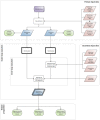Cumulative dietary risk assessment of chronic acetylcholinesterase inhibition by residues of pesticides
- PMID: 33613737
- PMCID: PMC7873834
- DOI: 10.2903/j.efsa.2021.6392
Cumulative dietary risk assessment of chronic acetylcholinesterase inhibition by residues of pesticides
Abstract
A retrospective cumulative risk assessment of dietary exposure to pesticide residues was conducted for chronic inhibition of acetylcholinesterase. The pesticides considered in this assessment were identified and characterised in a previous scientific report on the establishment of cumulative assessment groups of pesticides for their effects on the nervous system. The exposure assessments used monitoring data collected by Member States under their official pesticide monitoring programmes in 2016, 2017 and 2018, and individual food consumption data from 10 populations of consumers from different countries and from different age groups. Exposure estimates were obtained by means of a two-dimensional probabilistic model, which was implemented in SAS ® software. The characterisation of cumulative risk was supported by an uncertainty analysis based on expert knowledge elicitation. For each of the 10 populations, it is concluded with varying degrees of certainty that cumulative exposure to pesticides contributing to the chronic inhibition of acetylcholinesterase does not exceed the threshold for regulatory consideration established by risk managers.
Keywords: acetylcholinesterase inhibition; cumulative risk assessment; knowledge elicitation; pesticide residues; probabilistic modelling.
© 2021 European Food Safety Authority. EFSA Journal published by John Wiley and Sons Ltd on behalf of European Food Safety Authority.
Figures






Keys: Population groups:
BE .A (Belgian adults),CZ .A (Czech Republic adults),DE .A (German adults),IT .A (Italian adults),BG .C (Bulgarian children),FR .C (French children),NL .C (Dutch children),DK .T (Danish toddlers),NL .T (Dutch toddlers),UK .T (United Kingdom toddlers). The lower and upper edges of each boxplot represent the quartiles (P25 and P75) of the uncertainty distribution for each estimate, the horizontal line in the middle of the box represents the median (P50) and the ‘whiskers’ above and below the box show the 95% probability interval (P2.5 and P97.5).














Similar articles
-
Cumulative dietary risk characterisation of pesticides that have acute effects on the nervous system.EFSA J. 2020 Apr 29;18(4):e06087. doi: 10.2903/j.efsa.2020.6087. eCollection 2020 Apr. EFSA J. 2020. PMID: 32874295 Free PMC article.
-
Cumulative dietary risk characterisation of pesticides that have chronic effects on the thyroid.EFSA J. 2020 Apr 29;18(4):e06088. doi: 10.2903/j.efsa.2020.6088. eCollection 2020 Apr. EFSA J. 2020. PMID: 32874296 Free PMC article.
-
Cumulative dietary exposure assessment of pesticides that have acute effects on the nervous system using SAS® software.EFSA J. 2019 Sep 17;17(9):e05764. doi: 10.2903/j.efsa.2019.5764. eCollection 2019 Sep. EFSA J. 2019. PMID: 32626423 Free PMC article.
-
Retrospective cumulative dietary risk assessment of craniofacial alterations by residues of pesticides.Reprod Toxicol. 2024 Dec;130:108741. doi: 10.1016/j.reprotox.2024.108741. Epub 2024 Oct 31. Reprod Toxicol. 2024. PMID: 39486469 Review.
-
Cumulative risk assessment of pesticide residues in food.Toxicol Lett. 2008 Aug 15;180(2):137-50. doi: 10.1016/j.toxlet.2008.06.004. Epub 2008 Jun 8. Toxicol Lett. 2008. PMID: 18585444 Review.
Cited by
-
Mixture Risk Assessment of Complex Real-Life Mixtures-The PANORAMIX Project.Int J Environ Res Public Health. 2022 Oct 11;19(20):12990. doi: 10.3390/ijerph192012990. Int J Environ Res Public Health. 2022. PMID: 36293571 Free PMC article.
-
Retrospective cumulative dietary risk assessment of craniofacial alterations by residues of pesticides.EFSA J. 2022 Oct 6;20(10):e07550. doi: 10.2903/j.efsa.2022.7550. eCollection 2022 Oct. EFSA J. 2022. PMID: 36237417 Free PMC article.
-
Risk Assessment of Combined Exposure to Multiple Chemicals at the European Food Safety Authority: Principles, Guidance Documents, Applications and Future Challenges.Toxins (Basel). 2023 Jan 4;15(1):40. doi: 10.3390/toxins15010040. Toxins (Basel). 2023. PMID: 36668860 Free PMC article. Review.
-
Specific effects on kidneys relevant for performing a dietary cumulative risk assessment of pesticide residues.EFSA J. 2025 May 5;23(5):e9406. doi: 10.2903/j.efsa.2025.9406. eCollection 2025 May. EFSA J. 2025. PMID: 40330214 Free PMC article.
-
Pesticide Use and Degradation Strategies: Food Safety, Challenges and Perspectives.Foods. 2023 Jul 15;12(14):2709. doi: 10.3390/foods12142709. Foods. 2023. PMID: 37509801 Free PMC article. Review.
References
-
- Abd‐Elhakim YM, El‐Sharkawy NI, Mohammed HH, Ebraheim LLM and Shalaby MA, 2020. Camel milk rescues neurotoxic impairments induced by fenpropathrin via regulating oxidative stress, apoptotic, and inflammatory events in the brain of rats. Food and Chemical Toxicology, 135, 111055 10.1016/j.fct.2019.111055 - DOI - PubMed
-
- Ahmad I, Shukla S, Kumar A, Singh BK, Patel DK, Pandey HP and Singh C, 2010. Maneb and paraquat‐induced modulation of toxicant responsive genes in the rat liver: comparison with polymorphonuclear leukocytes. Chemico‐Biological Interactions, 188, 566–579. - PubMed
-
- Ansari RW, Shukla RK, Yadav RS, Seth K, Pant AB, Singh D, Agrawal AK, Islam F and Khanna VJ, 2012. Cholinergic Dysfunctions and Enhanced Oxidative Stress in the Neurobehavioral Toxicity of Lambda‐Cyhalothrin in Developing Rats. Neurotoxicity Research, 22, 292–309. 10.1007/s12640-012-9313-z - DOI - PubMed
-
- Banerjee BD, Seth V, Bhattacharya A, Pasha ST and Chakraborty AK, 1999. Biochemical effects of some pesticides on lipid peroxidation and free‐radical scavengers. Toxicology Letters, 107, 33–47. - PubMed
LinkOut - more resources
Full Text Sources
Other Literature Sources
